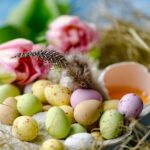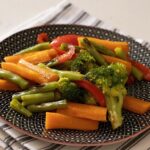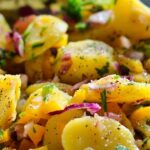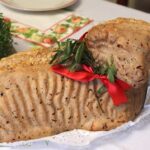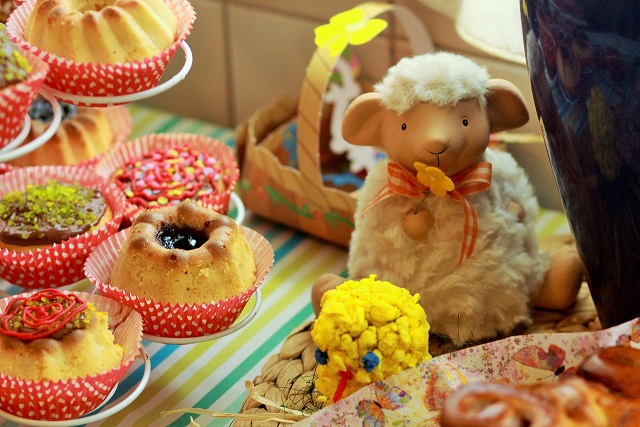
Easter in Germany is filled with delicious baked treats, and Osternest-Kekse are among the most delightful. These buttery, melt-in-your-mouth cookies are shaped into tiny nests, making them a charming addition to Easter brunch tables and festive gatherings. Traditionally, they are filled with colorful chocolate eggs, jam, or lemon curd, creating a beautiful and delicious Easter treat.
Osternest-Kekse are easy to make and perfect for baking with children. Their delicate texture and lightly sweet flavor pair well with a cup of coffee or tea. Whether you choose to fill them with Easter-themed chocolates or keep them simple with a dusting of powdered sugar, these cookies are a delightful way to celebrate the holiday.
In this guide, we’ll explore the history of Osternest-Kekse, their cultural significance, and provide a step-by-step recipe so you can bake these festive German cookies at home.
History & Cultural Significance
The Origins of Osternest-Kekse
Easter cookies have been a tradition in Germany and Austria for generations. Osternest-Kekse, or Easter Nest Cookies, are inspired by spring and renewal, symbolizing new life and rebirth—just like Easter eggs. These cookies are often baked as part of family traditions, allowing children to take part in shaping the dough and filling the centers with colorful decorations.
German Easter baking often features buttery doughs, ground nuts, and jam fillings, and these cookies reflect that tradition. While modern versions include chocolate eggs or even a drizzle of white chocolate, the classic recipe uses simple, high-quality ingredients to achieve a delicate and flavorful texture.
Want to explore more German Easter recipes? Check out our articles on Rüblikuchen and Traditional Dishes for Ostern.
Ingredients & Preparation (Step-by-Step Recipe Guide)
Ingredients for Authentic Osternest-Kekse
Cookie Dough:
- 250g (2 cups) all-purpose flour
- 100g (½ cup) sugar
- 150g (⅔ cup) unsalted butter, softened
- 1 egg yolk
- 1 tsp vanilla extract
- ½ tsp baking powder
- ¼ tsp salt
For Decoration:
- 2 tbsp apricot or raspberry jam (for classic filling)
- Small chocolate eggs (for decoration)
- 50g (½ cup) powdered sugar (for dusting)
Substitutes: For a nutty flavor, replace 50g of the flour with ground almonds or hazelnuts. To make them gluten-free, use almond flour instead of wheat flour.
How to Make Osternest-Kekse (Step-by-Step Instructions)
Step 1: Prepare the Dough
- In a mixing bowl, cream together the butter and sugar until light and fluffy.
- Add the egg yolk and vanilla extract, and mix until smooth.
- In a separate bowl, whisk together the flour, baking powder, and salt.
- Gradually add the dry ingredients to the butter mixture, mixing until a smooth dough forms.
Pro Tip: If the dough is too soft, wrap it in plastic wrap and chill for 30 minutes before shaping.
Step 2: Shape the Cookies
- Preheat the oven to 175°C (350°F) and line a baking sheet with parchment paper.
- Roll the dough into small balls (about 1 inch in diameter).
- Using your thumb or the back of a spoon, press a small indent in the center of each ball to create a nest shape.
Step 3: Bake the Cookies
- Bake for 10-12 minutes, or until the edges are lightly golden.
- Remove from the oven and let the cookies cool completely before filling.
Step 4: Fill & Decorate
- If using jam, warm it slightly and spoon a small amount into the center of each cookie.
- If using chocolate eggs, place them in the indent while the cookies are still slightly warm so they stick.
- Dust with powdered sugar for a classic finishing touch.
Serving Suggestions & Variations
How to Serve Osternest-Kekse
Osternest-Kekse are best served as part of an Easter tea or dessert spread alongside:
- A cup of black tea or espresso
- Other traditional Easter treats like Osterlamm (Easter Lamb Cake)
- A platter of fresh fruit and nuts
Variations & Regional Twists
In Austria, some bakers add a hint of lemon zest to the dough for extra freshness. In southern Germany, the cookies are sometimes made with ground almonds or hazelnuts for a richer flavor. Modern versions include a drizzle of white or dark chocolate instead of powdered sugar.
Want to try another classic German cookie? Check out our Vanillekipferl (Vanilla Crescent Cookies) recipe.
Baking Osternest-Kekse at home is a fun and festive way to celebrate Easter with a delicate, buttery treat. Whether filled with fruit jam, chocolate eggs, or left simple with powdered sugar, these cookies are a delightful addition to any Easter celebration.
Looking for more traditional German Easter recipes? Explore our recipes for Rüblikuchen, Osterzopf, and Hefezopf.


